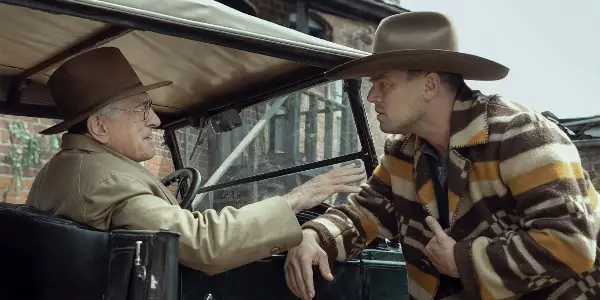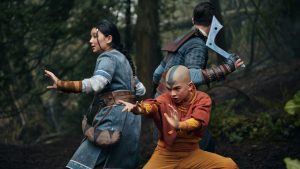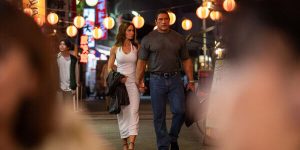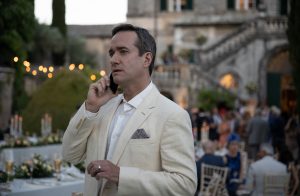
In preparation for Martin Scorsese‘s Killers of the Flower Moon, I read David Grann‘s book, to get a bit of background on the film’s story. I had vaguely heard of the murders, but didn’t know just quite how widespread and horrific it actually was. The conspiracy to systemically kill Osage tribal members and their family members, and then the witnesses themselves, and the sheer number of people involved in the coverups; it almost sounded unbelievable. In a way, it resembled the plot of a Scorsese movie.
How fitting, then, that Scorsese was the one to adapt this story. Though the subject matter may be new to him, the matter in which he approaches it is Scorsese through and through, and in a respectful way at that. It’s amongst his finer movies in an impressive career.
The Osage Murders
Killers of the Flower Moon takes place in the Osage nation in the 1920s. For a bit of background before the events of the film, the Osage are a tribe that is originally from the Kansas/Missouri area. They were moved to the current area of Oklahoma by the government, who believed the land to be worthless. Soon, though, the Osage strike oil and due to their ownership of the land, each member of the tribe owns headrights to it. For a time, they were per capita the richest people in the world.
Fast forward a few years, and white people have started to flock to the area, many of them marrying the Osage people. And, not so coincidentally, Osage members start dying mysteriously. The reason why is because of an iniital rule for the oil: only a tribal member is given headrights to it. Or, if you are married to a tribal member. Therefore, if a white man were to marry an Osage member and have their family killed, they would then inherit that tribal member’s headright. Despite efforts to appeal to the local authorities or as high as the U.S. government, the Osage are unable to resolve this case, even as the number killed rises dramatically.
Intimate Story Amongst a Larger Plot
Scorsese‘s film, much like Grann‘s novel, is more of an intimate affair, and focuses on a few select individuals, one family in particular. The family consists of Mollie (played by Lily Gladstone), her mother Lizzie Q (Tantoo Cardinal), and several sisters. At at the start of the film, one of her sisters had already died; soon two more follow, including Anna, who is shot, and Reta, who is the victim of a bombing. Shortly before this, Mollie had also married Ernest Burkhart (Leonardo DiCaprio), the nephew of William K. Hale (Robert De Niro), who both seem to love and care for the Osages as a whole. But outward appearances can be deceiving, as we soon find out.
source: Apple Original Films
What immediately works about Scorsese‘s film is this intimacy, allowing us to get to know a select few characters. By bringing us into the mindset of both Mollie’s family and the people immediately surrounding her, we gain a sense of the horrific events occurring across the Osage nation. The three key characters in this story are Mollie herself, her husband Ernest, and William Hale. And rightly so, the performances by these three are some of the true highlights of the film.
Superb Performances
Lily Gladstone, who had already proven herself in Kelly Reichardt‘s Certain Women, has a remarkable onscreen presence. Her performance is as subtle as it is emotionally affective; a sly offhanded look or remark often has more of an effect than any grandiose, over-the-top acting could have done. When she is sick, it is therefore that much more heartbreaking to see how such a strong character is brought to such a desolate place, through no fault of her own.
source: Apple Original Films
Leonardo DiCaprio, already well-known in Scorsese‘s ouvre, here gives one of his best performances of them all. His Ernest is an odd, off-putting man, with a permanent pursed lower lip and a softspoken manner. DiCaprio commits to the role, also bringing just enough charm to make him likable as well, which is conflicting once we see what Ernest is capable of. It is his sincere love for Mollie that makes this him more troubling, as we see how he is manipulated by his uncle at the same time. It is one of DiCaprio‘s most complex roles.
De Niro, another Scorsese longtimer, has found a role more than worthy of him, considering his typical persona in many of those movies. Here, as opposed to a brash Italian gangster, he has a gentelmanly Southern charm, capable of winning over almost everyone, including the Osage people. It is as soothing as it is alarming, especially once when we see that there is no limit to what he will do to get the Osages’ money.
Authenticity and Humanism
When Martin Scorsese was originally brought on to direct this film, there was some controversy, since some people thought he might not be the right person to tell this story. It appears that Scorsese listened to these concerns, and he then made the Osage people consultants and key players both behind and in front of the screen. He drew on their culture, and respectfully tells the story of the people, often letting them speak for themselves. The end result shows.
source: Apple Original Films
One of the key examples of this is a scene taking place inside of a hut, in which many members of the Osage tribe have gathered to discuss the recent murders and what they can do about it. The leaders of the tribe speak their piece in a compelling manner, capturing the rapt attention of those sitting amongst them. Apparently, much of this scene is actually improvised, and Scorsese just let the Osage tribal members speak authentically. It’s a sign that maybe he was the right person to tell this story after all.
A Scorsese Film
Much of Killers of the Flower Moon does resemble a typical Scorsese picture, perhaps most similar to Goodfellas. The subject matter of that film is very similar to this: that of a compassionate man (Ernest) getting caught up in the crimes of his family (Hale), who manipulate him to commit unspeakable acts. And the way he tells the story is also analogous, as we see much of it through Ernest’s perspective. A key difference, though, is that we also see the perspective of the Osage, specifically that of Mollie.
In typical Scorese fashion, he used several tracking shots from the perspective of a character, in which we see both white people and Osage react to their presence; interestingly, he only does this for Mollie and nobody else. The film’s limited voiceover narration is also through Mollie’s voice. So while much of the film does get into the complexity of Ernest’s behavior, it’s Mollie’s point of view that we clearly want to align ourselves with.
source: Apple Original Films
Another common feature that Scorsese utilizes is the score of Robbie Robertson, a Scorsese frequenter, who tragically passed away in August of this year. Robertson, who also grew up on an Indigenous reservation, draws on some of his own background for Killers of the Flower Moon. For much of the film, it is simply a pulsating beat in the background, propelling the events along. At others, the score becomes loud and primal, which is Robertson attempting to insert the sounds of a coyote and other animals. It works remarkably well.
The Epic
Killers of the Flower Moon covers several key moments in the Osage murders, including the deaths of every member of Mollie’s family other than her. It shows the people involved, including Ernest and Hale, the people they hire, and the people affected. There is a lot to unravel here, and Scorsese shows you many intimate details and conversations of those involved. In a film stretching over 3 hours, it’s a wonder that it doesn’t overly drag, which is a testament to Thelma Schoonmaker‘s editing talents.
One event that isn’t focused on nearly as much, though, is the investigation behind the murders, which I found to be one of the more fascinating parts of David Grann‘s book. Tom White, played by Jesse Plemons, is brought on from the Bureau of Investigation (the precursor to the FBI), and he discovers just how widespread the Osage murders conspiracy goes, from Hale and Burkhart outwards to doctors, local officials, and more. Perhaps, in a movie of this length, there just wasn’t enough time to show enough of this.
The conclusion of Killers of the Flower Moon is another slight letdown. After a moderately-paced first and second act, the third proceeds at almost breakneck pace. Ernest and Hale’s crimes have caught up to them, and just when you think this may turn into a courtroom drama of sorts, instead it gets choppy, skipping ahead to future events without giving us a chance to let the initial ones settle.
An example of this is the first scene we glimpse into the courtroom, in which Brendan Fraser first appears as Hale’s attorney, and John Lithgow as the prosector. Almost immediately, the proceedings are interrupted by a shouting Fraser, and the scene abruptly ends. It’s perhaps Scorsese‘s way of subverting our expectations; this isn’t meant to be a courtroom drama, so don’t get comfortable. At the same time, it does waste the talents of both Fraser and Lithgow.
A True Story Forgotten in American History
Regardless of how this story was told, this is a story that needed to be told. Coincidentally taking place alongside the Tulsa race massacre in 1921, this is also one of the more tragic, dark, and unspoken events in American history. When you hear of a story like this, it sounds like something that would happen in the old West, when rules were harder to enforce and many horrific events occurred without consequence. But to learn that this just in the last hundred years makes it all the more alarming.
In Grann‘s book, he also focuses a great deal on Mollie’s family and the murders that occurred around them. But in the last few chapters, he looks into other mysterious deaths of the Osage people, by asking Osage descendants and doing further research. He estimates that the true death toll could have been in the hundreds, and that there were more than just a handful of people involved in the killings, as seen in the film. Someone had to speak for these people. And through Grann‘s novel and now Scorsese‘s adaptation of it, perhaps we finally have.
Conclusion
To conclude, Killers of the Flower Moon is both a faithful adaptation and a masterful epic from Martin Scorsese. It is authentic, respectful, and informative, exuding the talents of those both in front of and behind the screen. It is an acknowledgement of our bloodied past, because it is only by looking back that we can hope to move forward. And Killers of the Flower Moon is a worthy start towards healing.
Killers of the Flower Moon is now playing exclusively in theaters.
Does content like this matter to you?
Become a Member and support film journalism. Unlock access to all of Film Inquiry`s great articles. Join a community of like-minded readers who are passionate about cinema – get access to our private members Network, give back to independent filmmakers, and more.





